
By Sara Flounders
THE RECURRING MEDIA IMAGE OF YUGOSLAVIA in the United
States and Europe is of desperate people fleeing local war and
ethnic hatred or living a precarious existence dependent on
United Nations convoys for their next meal.
According to the United Nations High Commission on Refugees, this
is the largest refugee population in the world. By 1994 figures,
there are over 3.7 million war refugees in the former Yugoslavia.
The war has taken its toll on all participants in the struggle.
Of the refugees, 44% are Muslim, 36% are Serbs and 20% are
Croatian. The enormous human suffering represented in these cold
statistics cannot be calculated.
The very names Bosnia and Serbia are now associated with “ethnic
cleansing,” mass rape, atrocities and age-old national hatreds.
U.S. involvement, UN troops and NATO forces are depicted as
peacekeepers or neutral forces that are carrying out humanitarian
or diplomatic missions. When UN officials, NATO generals, and
U.S., British, French or German diplomats meet it’s to discuss
the newest peace plan. Every measure is always described as being
based on deep concern over how to end the fighting.
Is the civil war raging in Yugoslavia a case of spontaneous
combustion caused by “ancient ethnic hatreds” burning out of
control? Is the U.S. government an innocent bystander? Is the
real problem presidential indecision about how to defend a small,
oppressed Bosnian Moslem government targeted by the new fascists
of the 1990s the Serbs?
Age-old ethnic hatred among small nationalities didn’t just
explode into modern-day barbarism. Rather, war exists in the
region as a result of the intervention of outside powers. In this
process the U.S. has been neither an innocent bystander nor a
neutral party.
A closer examination of the root causes of the incredibly
destructive civil war raging in the region yields a completely
different picture.
The reality is that the U.S. government lit the fire in the
Balkans. At every stage Washington has acted as an arsonist
pouring gasoline on the flames.
The greatest responsibility for the dismemberment of Yugoslavia
and the resulting civil war lies with the U.S. government. It was
not an accident or an oversight. It was a policy decision.
Each step the U.S. has taken has widened the war and increased
divisions in the region.
ORIGINS OF THE BREAKUP A U.S. LAW

A year before the breakup of the Socialist Federal Republic of
Yugoslavia, on Nov. 5, 1990, the U.S. Congress passed the 1991
Foreign Operations Appropriations Law 101-513. This bill was a
signed death warrant. One provision in particular was so lethal
that even a CIA report described three weeks later in the Nov.
27, 1990, New York Times predicted it would lead to a bloody
civil war.
A section of Law 101-513 suddenly and without previous warning
cut off all aid, trade, credits and loans from the U.S. to
Yugoslavia within six months.

It also ordered separate elections in each of the six republics
that make up Yugoslavia, requiring State Department approval of
election procedures and results before aid to the separate
republics would be resumed. The legislation further required
U.S. personnel in all internationalfinancial institutions such
as the World Bank and the International Monetary Fund to enforce
this cut-off policy for all credits and loans.
There was one final provision. Only forces that the U.S. State
Department defined as “democratic forces” would receive funding.
This meant an influx of funds to small right-wing nationalist
parties in a financially strangled region suddenly thrown into
crisis by the overall funding cut-off.
The impact was, as expected, devastating.
This law threw the Yugoslav federal government into crisis. It
was unable to pay the enormous interest on its foreign debt or
even to arrange the purchase of raw materials for industry.
Credit collapsed and recriminations broke out on all sides.
At the time there was no civil war. No republic had seceded. The
U.S. was not engaged in a public dispute with Yugoslavia. The
region was not even in the news. World attention was focused on
the international coalition the Bush administration was
assembling to destroy Iraq a war that reshaped the Middle East at
a cost of half a million Iraqi lives.
What was behind the sweeping legislation directed at Yugoslavia,
especially when U.S. policy makers themselves predicted that the
sudden unraveling of the region would lead to civil war?
With the collapse of the Soviet Union, U.S. big business was
embarking on an aggressive march to reshape all of Europe.
Nonaligned Yugoslavia was no longer needed as a buffer state
between NATO and the Warsaw Pact. A strong, united Europe was
hardly desirable. Washington policy makers considered both to be
relics of the Cold War.
CONTROL OF THE PURSE STRINGS
This one piece of legislation Law 101-513 demonstrates the U.S.
government’s enormous power. It was one part of annual
legislation that defines in detail policies to be pursued in
every region of the globe. The Foreign Operations Act implements
U.S. corporate control through major funding to international
financial institutions such as the Inter-American Development
Bank, Asian Development Fund, the African Development Fund, and
through direct assistance to individual countries.
The deadly restrictions on Yugoslavia took a mere 23 lines.
Compare this to the more than nine pages that detail sanctions to
be imposed on Iraq. As of January 1995, the U.S.-UN sanctions on
Iraq had killed more than half a million children. This
projection is from Thomas Ekfal, the United Nations Children’s
Fund representative in Baghdad. (New York Newsday, Dec. 19, 1994)
The 1990 foreign appropriations law also prescribed various forms
of economic strangulation for several other countries deemed
enemies, including Angola, Cambodia, Cuba, Iran, Iraq, Libya,
Syria, Korea (DPRK) and Vietnam. On the other hand countries
moving hastily toward a capitalist market economy in 1990, such
as Poland, were to receive special funding.
In all the expressions of concern and sympathy for refugees and
displaced people in countries all over the globe, but especially
in the former Yugoslavia, no U.S. official ever mentions the
terrible suffering caused by U.S. economic strangulation.
Of course, financial strings were hardly new to Yugoslavia in
1990. Yugoslavia had become utterly dependent on loans from
Western banks. The increasingly onerous conditions had dislocated
the economy. A year earlier, the price of continued U.S. loans
and credits was a brutal austerity program that devalued the
currency, froze wages, cut subsidies, closed many state
industries deemed unprofitable for capitalist investors and
increased unemployment to 20 percent. The result was strikes,
walkouts, a sharp increase in political and economic tension,
and, above all, an upsurge in national antagonisms on all sides.
Once the U.S. acted so decisively toward Yugoslavia in 1990, the
European powers were hardly willing to be bystanders to the
enforced break-up of a country in their own backyard. The U.S.
Foreign Appropriations Bill sent a clear message to the European
powers that Yugoslavia and the whole Balkan region of Europe were
again up for grabs. On their own they might never have dared to
act. Now they dared not be out of the action.
EUROPEAN INTERVENTION
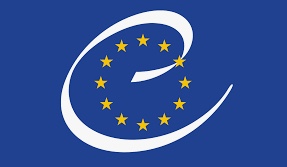
By February 1991 the Council of Europe followed the U.S. measure
with its own political demands and explicit economic intervention
in the internal affairs of the Yugoslav Federation. Their demand
was similar: that Yugoslavia hold multi-party elections or face
economic blockade.
Right-wing and fascist organizations not seen in 45 years since
the defeat of the Nazi occupation by the anti-fascist partisan
movement were suddenly revived and began receiving covert
support. These fascist organizations had been maintained in exile
in the U.S., Canada, Germany and Austria. Now they became the
main conduit for funds and arms.
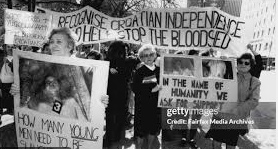
By March 1991, Croatian fascists were organizing attacks and
demonstrations calling for the overturn of the socialist
federation and the expulsion of all Serbs from Croatia.
On May 5, 1991, the date of the six-month deadline imposed by
U.S. Foreign Operations Law 101-513, Croatian separatists staged
violent demonstrations and besieged a military base in Gospic.
The Yugoslav Federal Government, under attack, ordered the army
to intervene. The civil war had begun. Slovenia and Croatia
declared independence on June 25, 1991.

In Croatia the right-wing party, the Ustashi, came to power using
fascist symbols and slogans from the era of Nazi occupation. Its
program guaranteed a return to capitalist property relations and
denied citizenship, jobs, pensions, passports or land ownership
to all other nationalities, but especially targeted the large
Serbian minority.

In the face of armed expropriations and mass
expulsions, the Serbs in Croatia began to arm themselves. The
experience of World War II when almost a million people,
primarily Serbs, but also Jews, Romani and tens of thousands of
others died in Ustashi death camps fueled the mobilization.
As the largest nationality and the one that opposed the breakup
of the Yugoslav Federation, the Serbs became the target and the
excuse for Western intervention. History was turned on its head
as the media portrayed the Serbs as fascists. In 1991, right-wing
nationalist parties swept the elections in Slovenia and Croatia.
However, in Serbia and in Montenegro the mass mood was
overwhelmingly for the federation and also against further
privatization or other capitalist inroads. This was an unexpected
resistance to the political collapse sweeping Eastern Europe at
the time.
The tactic of targeting the Serbs with UN resolutions, imposing
brutal sanctions, and freezing all credit and trade also serves
as a veiled threat against Russia. The breakup and dismemberment
of the Soviet Union has been encouraged by the same forces that
encouraged the breakup of Yugoslavia.
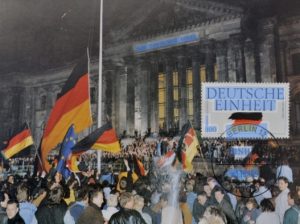
Reunited Germany moved aggressively into the region to
consolidate its position. It was the first to openly grant
diplomatic recognition to the break-away republics.
The U.S. State Department’s position after Croatia and Slovenia
seceded was official support for a continued federation. But this
flew in the face of the demands and the process set in motion by
the U.S. Foreign Operations Law passed in 1990 before the
Yugoslav civil war began.
REWRITING HISTORY
The rationale behind Western intervention in Yugoslavia is based
on rewriting history.
Every debate about drawing and redrawing the map of Bosnia
assumes the right of the Western powers as outside “neutral”
forces to carve up and decide the fate of the region in the
interests of “peace.” The implied justification is that the
small, barbaric nations of the Balkans are so torn by ethnic
hatred that they are incapable of deciding anything themselves.
There is a bloody history in the Balkans but it’s not the one
that’s being connected to the present-day struggle. It’s much
more to the point. That’s the history of the major imperialist
powers battling for control and domination of this strategic
crossroads of Europe and the Middle East.
The history of modern Europe sometimes seems to revolve around
carving and recarving the Balkans. It is a history of continually
redrawing borders and defining regions of influence, of arming
mercenary bands and holding international conferences in Paris,
in Berlin, in London and at the Hague to confer about which power
would be in control of what region. All this was always without
any consultation with the many small nationalities whose fate
hung in the balance.
The Austro-Hungarian Empire, Ottoman Turkey, Czarist Russia,
Britain, France, Germany and Italy have all considered the
Balkans their rightful “sphere of influence.” World War I began
in Sarajevo. Although the competition and rivalry for markets
extended globally far beyond the Balkans this small region has
always been a tinderbox for the big powers.
For 45 years the Yugoslav Federation six republics and two
autonomous regions was able to hold the Western powers at bay. It
was able to develop industry in an impoverished, underdeveloped
area and raise the standard of living. The fact that the IMF and
U.S. banks were able to again strangle and dismember it does not
negate its historical accomplishment.
CASTING THE SERBS AS FASCISTS
How did the Serbs come to be viewed as fascists in this
developing conflict? This characterization has now become an
accepted fact, an issue beyond debate. It makes U.S. motives seem
unimpeachable and on the side of good against evil.

An April 1993 interview by Jacques Merlino, associate director of
French TV 2, with James Harff, director of Ruder Finn Global
Public Affairs, a Washington, D.C.-based public relations firm,
explains the role of the corporate media in shaping a political
issue.

Harff bragged of his services to his clients, the Republic of
Croatia, the Republic of Bosnia-Herzegovina and the parliamentary
opposition in Kosovo, an autonomous region of Serbia. Merlino
described how Harff uses a file of several hundred journalists,
politicians, representatives of humanitarian associations, and
academics to create public opinion. Harff explained:
“Speed is vital … it is the first assertion that really counts. All
denials are entirely ineffective.”
In the interview, Merlino asked Harff what his proudest public
relations endeavor was. Harff responded:
“To have managed to put Jewish opinion on our side. This was a
sensitive matter, as the dossier was dangerous looked at from
this angle. President Tudjman was very careless in his book,
‘Wastelands of Historical Reality.’ Reading his writings one
could accuse him of anti-Semitism. [Tudjman claimed the Holocaust
never happened S.F.] In Bosnia the situation was no better:
President Izetbegovic strongly supported the creation of a
fundamentalist Islamic state in his book, ‘The Islamic
Declaration.’
“Besides, the Croatian and Bosnian past was marked by real and
cruel anti-Semitism. Tens of thousands of Jews perished in
Croatian camps, so there was every reason for intellectuals and
Jewish organizations to be hostile toward the Croats and the
Bosnians. Our challenge was to reverse this attitude and we
succeeded masterfully.
“At the beginning of July 1992, New York Newsday came out with
the article on Serb camps. We jumped at the opportunity
immediately. We outwitted three big Jewish organizations the
B’nai B’rith Anti-Defamation League, The American Jewish
Committee and the American Jewish Congress. In August, we
suggested that they publish an advertisement in the New York
Times and organize demonstrations outside the United Nations.
“That was a tremendous coup. When the Jewish organizations
entered the game on the side of the [Muslim] Bosnians we could
promptly equate the Serbs with the Nazis in the public mind.
Nobody understood what was happening in Yugoslavia. The great
majority of Americans were probably asking themselves in which
African country Bosnia was situated.
“By a single move, we were able to present a simple story of good
guys and bad guys which would hereafter play itself. We won by
targeting the Jewish audience. Almost immediately there was a
clear change of language in the press, with use of words with
high emotional content such as ethnic cleansing, concentration
camps, etc., which evoke images of Nazi Germany and the gas
chambers of Auschwitz. No one could go against it without being
accused of revisionism. We really batted a thousand in full.”
Merlino: “But between 2 and 5 Aug. 1992 when you did this you had
no proof that what you said was true. All you had were two
Newsday articles.”
Harff: “Our work is not to verify information. We are not
equipped for that. Our work is to accelerate the circulation of
information favorable to us, to aim at judiciously chosen
targets. We did not confirm the existence of death camps in
Bosnia, we just made it widely known that Newsday affirmed it.
… We are professionals. We had a job to do and we did it.”
THE RAPE CHARGE
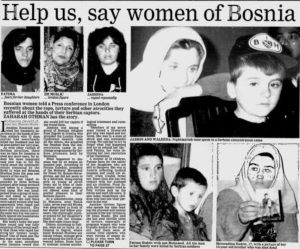
One charge against the Serbs has aroused the anger and shaped the
view of millions of people who previously had little interest or
involvement in the Balkans. The charge is rape – rape as a
media asserts that rapes were a conscious policy and the
responsibility of the Bosnian Serb leadership.
Between the fall of 1992 and spring of 1993 sensational news
reports claimed that at least 20,000 and up to 100,000 Muslim
women were raped by units of the Bosnian Serb Army.
Muslims the victims.
Women are the first victims in every war. Rape and the degrading
abuse of women are all too often carried out as a stamp of
conquest by invading armies imbued with patriarchal possessive
attitudes. But the charge of rape has many times been consciously
that defense of women is used to mobilize armies and galvanize blind
hatred.
The sensational charges of rape were used to a cynical extent by
the major corporate media, especially in the U.S., with no
attempt to examine the sources. The foreign minister of Bosnia-
talks in Geneva that 30,000 women and girls had been raped. Ms.
magazine ran a cover story that accused Bosnian Serb forces of
raping for the purpose of producing pornographic films. No such
films were ever found and the charges were not supported by the
findings of Helsinki Watch or Human Rights Watch.
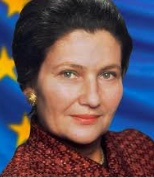
Thee European Community estimated 20,000 Muslim women had
been raped as part of a Serb strategy of conquest. This report was
widely cited as an independent, authoritative source. No coverage
was given to a dissenting member of the investigative team, Simone
Veil, a former French minister and president of the European Parliament.
She revealed that the estimate of 20,000 victims was based on
actual interviews with only four victims two women and two men.
According to the New York Times of Oct. 19, 1993, the Croatian
Ministry of Health in Zagreb was the main single source upon
which the Warburton Report based its figure of 20,000.

The Jan. 4, 1993, issue of Newsweek reported that up to 50,000
Muslim women had been raped in Bosnia. Tom Post, a contributor to
the article, explained that the estimate of 50,000 rapes was
based on interviews with 28 women.
This estimate was the result of an extrapolation multiplying each
charge of rape by a certain factor because historically rape has
been and continues to be an under-reported crime.

French television reporter Jerome Bony explained the problem.
“When I was 50 kilometers from Tuxla, I was told: `Go to the
Tuxla high school grounds. There are 4,000 raped women.’ At 20
kilometers this figure dropped to 400. At 10 kilometers only 40
were left. Once at the site, I found only four women willing to
testify.”
The Jan. 15, 1993, New York Times, carried a photo story with the
caption: “A two-month-old baby girl born to a teen-age Muslim
woman after she was raped in a Serbian detention camp.” USA Today
of Jan. 13, 1993, told the story of a five-month-old baby,
presumably the product of systematic Serbian rape. At that time,
the war was not yet nine months old.
Women’s organizations understandably outraged by these lurid
reports demanded that the U.S. and the European powers take
action. However, many of these same women ought to be aware that
U.S. troops do not protect women. In every U.S. military
operation an entire sex industry is created and tens of thousands
of women are forced into sexual slavery and prostitution.
Consider the experience of Vietnam, Thailand, Korea and the
Philippines. Even U.S. women in the military experience rape and
sexual abuse, then cover-ups and denial, as the Tailhook scandal
so graphically demonstrated.
CONTROL THROUGH DIVISION IN BOSNIA
The divisive U.S. role in Bosnia, the most multi-ethnic of the
regions, raises other questions. Does the U.S. seek, through the
breakup of Yugoslavia, not only to position itself in the region
but to advance a more complex, hidden agenda? Certainly U.S.
conduct has involved many maneuvers that have prolonged the war
and increased the rivalry among Britain, France and Germany.
Turkey, Greece and Italy have also historically been involved in
the region and are again maneuvering.

On March 18, 1992, a negotiated agreement for a unified state
brokered by the European Community was reached in Lisbon among
the Bosnian Muslim, Croatian and Serb forces. This agreement of
all three parties would have prevented the disastrous civil war
that began that same year. It would have saved the hundreds of
thousands of refugees whose lives have been destroyed by war.

Washington sabotaged this original agreement by telling the
Bosnian regime of Alija Izetbegovic that it could get much
more possibly domination of the whole region with U.S. backing.
The U.S. role in destroying this carefully crafted agreement is
acknowledged by all sides. Even the June 17, 1993, New York Times
described Washington’s role. The U.S. government officially
encouraged Izetbegovic, the head of the right-wing Party for
Democratic Action, to unilaterally declare a sovereign state
under his presidency.
Muslim groups in two separate areas of Bosnia have challenged the
government led by Alija Izetbegovic. They dispute Izetbegovic’s
claim that he represents the interests of the Muslim community.
They want a policy of cooperation and trade with the other
nationalities of the region. Both groups have condemned
Izetbegovic for right-wing nationalist policies and reliance on
U.S. military aid.
The elected Bosnian Muslim government in the city of Tuzla, one
of the wealthiest industrial centers of old Yugoslavia, claims
that the U.S.-supervised rewrite of the Bosnian constitution gave
power only to the most extreme right-wing nationalist forces of
Izetbegovic’s Party for Democratic Action and neo-fascist Franjo
Tudjman’s Croatian Democratic Union. Other political forces even
among Muslims were excluded.

A Bosnian Muslim group in the northwest Bihac area led by Fikret
Abdic declared its autonomy from the U.S.-backed government based
in Sarajevo. In retaliation, the Izetbegovic government launched
a military attack against these Muslim forces that wanted peace
with their Serbian and Croatian neighbors.
This attack on an elected Moslem Bosnian government was organized
by the U.S. As was reported in November 1994 in Britain in such
newspapers as the Guardian, the Observer and the Independent as
well as newspapers in France and Germany, six U.S. generals took
part in planning the offensive in June 1994. The attack violated the
cease-fire and a UN-declared safe area.
The Izetbegovic government’s U.S.-backed offensive was at first
successful in the Bihac region. But the Bosnian Serbs, in
alliance with Serbs in Croatia and Bosnian Moslem forces led by
Fikret Abdic, reorganized and began a strong push back. U.S.
bombers under NATO command came to Izetbegovic’s defense.
In the U.S. media, neither the U.S. role in planning the
offensive nor the fact that the U.S.-backed forces were the ones
to violate the cease-fire was examined. The Bosnian Muslim forces
opposing the Izetbegovic government based in Sarajevo have
received only scant mention as “renegade forces.”

Retired U.S. Air Force Gen. Charles G. Boyd, the deputy commander
in chief of the U.S. European Command from 1992 to 1995, wrote in
the September/October 1995 issue of Foreign Affairs magazine that
Abdic’s government in Bihac was “one of the few examples of
successful multi-ethnic cooperation in the Balkans.” Further,
Boyd writes, “Abdic, a powerful local businessman, was a member
of the Bosnian collective presidency. He outpolled Izetbegovic in
national elections and had been expelled from the government when
Sarajevo [Izetbegovic’s headquarters] rejected an internationally
brokered peace agreement.”
U.S. backing of Izetbegovic’s attack on other Bosnian Muslim
forces exposes just how cynically the Pentagon is using right-
wing Muslim forces in order to prolong and widen the war. Those
who call on the Pentagon to come to the defense of Muslim people
should recall the U.S. role in the Middle East. The U.S.
government has demonized Muslim people and made war on the people
of Palestine, Libya, Lebanon, Iraq, Iran and Somalia. Muslim
people in Bosnia will be the greatest losers in this war-torn
region as a result of the alliance of the narrow, right-wing
Izetbegovic grouping and the Pentagon.
THE CIA ROLE IN BOSNIA
Another view of U.S. aims and U.S. involvement develops from
reading the European press.
Here are some headlines from the British press:
“CIA agents training Bosnian army,” The Guardian (Nov. 17, 1994)
“America’s secret Bosnia agenda,” The Observer (Nov. 20, 1994)
“How the CIA helps Bosnia fight back,” The European (Nov. 25,
1994)
“Allies facing split over Bosnia,” The Independent (Nov. 12,
1994)
“Europe braces for more rows with U.S.,” The Guardian (Nov.12,
1994)
These few headlines expose both the CIA role in Bosnia and the
depth of the growing dispute in NATO. The media in France,
Germany and Italy have carried similar exposes of large-scale CIA
involvement in the widening war in Bosnia.
Coverage has included information on tactical operations, sharing
satellite information and controlling local air traffic. Units of
both the Croatian and Bosnian armies have reportedly been trained
within the region and in the U.S. U.S.-based forces have provided
assistance in building airstrips and organizing large weapons
shipments through Croatia to the Bosnian forces.
Also reported was the meeting of six U.S. generals with the
leaders of the Bosnian army to plan the military offensive that
broke the nine-month cease-fire in Bosnia and opened the fighting
in the UN-declared “safe zone” of Bihac. All of this immediately
raises the question, how long has the CIA been involved? What is
its purpose? The budget of the CIA is today three times the
budget of the U.S. State Department.
The debate in the European press complete with Pentagon denials
and “clarification” has received scant coverage in the U.S.
media. This avoidance of an issue receiving wide coverage in
Britain and France raises further questions of why the major U.S.
media are aiding and abetting this operation and why the European
media are exposing this information.
The exposes follow months of increasingly sharp criticisms and
veiled charges by UN officials that the U.S. has sabotaged each
agreement, peace plan and even the cease-fires.
It is clear that the civil war in Yugoslavia has broken the
growing unity of the European powers. They are at each other’s
throats over how to proceed. The struggle between the use of UN
peacekeepers versus NATO bombing reflects these divisions.
UN LEAKS INFORMATION ON U.S. ROLE
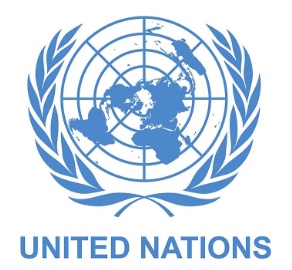
Occasionally the debate makes it into the back pages of U.S.
newspapers. On April 30, 1994, the Washington Post cited two
senior UN officials a general and a civilian who blame the U.S.
“for the continuation of the war in Bosnia because it has given
the Muslim-led Bosnian government the false impression that
Washington’s military support was on the way.”
The article explained that the officials interviewed were two of
the highest ranking UN representatives in Bosnia. Yet they feared
using their names lest they be expelled from Bosnia. However,
both claimed that U.S. moral and financial support of the
Izetbegovic regime was prolonging the war.
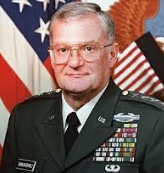
The officials accused the U.S. of leading on Izetbegovic’s forces
by promising full-scale NATO intervention on his side. U.S. Gen.
John Shalikashvili, chair of the U.S. Joint Chiefs of Staff, had
gone to Sarajevo to meet with Bosnian military leaders. It was a
powerful incentive to keep fighting.

That was reinforced when, in an impassioned speech at the opening
of the new U.S. Embassy in Sarajevo, U.S. Ambassador to the UN
Madeleine Albright said, “Your future and America’s future are
inseparable.”
On June 24, 1994, the New York Times described the new supplies,
including heavy weapons, flooding into Bosnia since the U.S.
organized the Croatian-Bosnian alliance.
Each “peace proposal” or map defining the areas of Moslem or Serb
control divides the area into dependent, unsustainable enclaves
needing constant resupply, which would require a military
presence for many years. Industrial centers and the major roads
in this mountainous region are partitioned so the Bosnian
government based in Sarajevo controls them. The Bosnian Serbs
have been allocated the poorest rural and mountainous regions
with no connecting roads or corridors between them. The Bosnian
Serbs cannot survive under these plans. Their situation is
untenable. They are driven to resist.
USE OF WAR PROPAGANDA
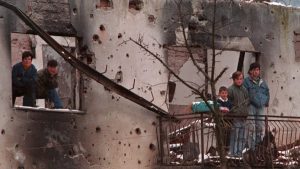
The siege of Gorazde in the spring of 1994 is one of the clearest
examples of the U.S. propaganda barrage to justify and demand
measures that would widen the war and give the U.S. military a
blank check. Nightly news broadcasts about Gorazde focused on the
Serbian bombing of a hospital and claimed casualties in the
thousands. Then, after days of gory stories in the media and
heavy U.S. pressure, U.S. planes flying under NATO auspices
bombed Serb positions. A heated UN Security Council debate and
vote, however, blocked the full-scale NATO air strikes that the
U.S. was demanding.

After the siege was lifted, the commander of UN troops in Bosnia,
British Army Lt. Gen. Michael Rose, told visiting U.S. Rep. John
P. Murtha, chair of the House Appropriations Committee
subcommittee on defense, that reports of damage and casualties
were greatly exaggerated. The Bosnian casualties around Gorazde
“were closer to 200 than 2,000.” The media had wildly
exaggerated casualties in order to promote a war climate and
justify NATO intervention.
The UN officials found that the hospital in Gorazde, which had
been repeatedly described as all but destroyed by the Serbs,
basically needed a broom to clear up the rubbish. It was still
functioning. The hospital had been damaged because the
Izetbegovic government forces had established their military
headquarters next to the hospital.
After the siege ended, a report in the April 24, 1994, New York
Times referred to a giant munitions factory in Gorazde under
Bosnian Muslim control. The Pabjeda Munitions Factory includes “a
honeycomb of underground tunnels and storage bunkers.” There were
“enough explosives in the factory to flatten a city.” Throughout
the siege the public has been bombarded with countless stories on
the plight of unarmed Bosnian Muslim forces versus a well-armed
Bosnian Serb army.
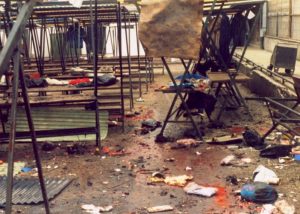
World sympathy for the government of Izetbegovic has been built
mainly through horror stories of brutal Serbian attacks on
unarmed civilians in Sarajevo. One of the most gruesome was an
attack on an open-air market that left 68 people dead on Feb. 5,
1994. As the rift between the U.S. forces and the British and
French forces under UN flag grows more heated, these widely
publicized “Serb atrocities” are being disputed. A UN analysis
of the crater showed that the Izetbegovic regime’s forces were
responsible for the explosion at the market. (Reuters, Feb. 18,
1994) Later, the UN publicly released a crater analysis of another
shell that exploded, wounding a child, as proof that
Izetbegovic’s Bosnian army had fired on its own civilians to gain
sympathy. (New York Times Nov. 10, 1994)
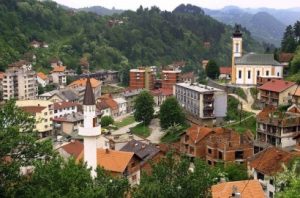
Just a few weeks earlier U.S. war propaganda had reached new
depths with gory descriptions of carnage, mass rapes,
disembowelment, even massacres of children when the Bosnian
government pulled out of Srebrenica. However, a UN investigative
team reported on July 24, 1995, that they could not find a single
eyewitness to any atrocity.

Hubert Wieland, personal representative of the UN high commission
for human rights, traveled with a team of investigators to
Srebrenica and to Tuzla, the Bosnian city to which almost all the
refugees were taken. Although his team spoke with scores of
Muslims at the main refugee camp and at other collection centers,
no eyewitness could be found.
U.S. SUPPORT FOR CROATIAN INVASION OF KRAJINA

In contrast to the storm of outrage in the media when the Serbs
moved into the town of Srebrenica, there was no such coverage two
weeks later when on Aug. 3, 1995, in a blitzkrieg attack,
Croatian forces with U.S. backing launched the biggest and the
bloodiest offensive in four years of civil war.
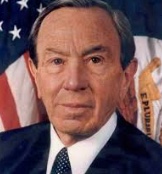
Within a week 200,000 new refugees were fleeing the Croatian
army. However, there was no coverage of these old people being
driven from their homes or the chaos of thousands fleeing the
bombing of their villages. There was no sympathy and there was no
talk of sanctions on Croatia. Secretary of State Warren
Christopher declared that the crushing military offensive was “to
our advantage.”
Pentagon support amounted to far more than just a nod of
approval. According to the London Independent of Aug. 6, 1995,
“The re-arming and training of Croatian Forces in preparation for
the present offensive are part of a classic CIA operation:
probably the most ambitious operation of its kind since the end
of the Vietnam war.”
The London Times of Aug. 5 reported that “the rearming of Croatia
remains one of the biggest untold stories of the Yugoslav war.
American officials strenuously deny any involvement in this
operation but the region is teeming with former generals who
unconventionally chose the Balkans, rather than Florida, for
their well-earned retirement.”
‘SAFE AREAS’ LAUNCHING PADS FOR U.S. WAR
On a daily basis news coverage in the U.S. refers to Serb
violations of UN-declared “safe areas,” six towns held by the
Bosnian government and surrounded by Serb-held territory. This
term reinforces the popular misconception that the “safe areas”
are neutral, demilitarized, civilian havens removed from the
civil war. U.S. military support has made this term a cynical
fraud.
The excuse for every NATO bombing of the Bosnian Serb forces has
been an alleged Serb attack on a “safe area.” But it is U.S.
military intervention that has made these “safe areas” unsafe.

The “safe areas” are really staging areas for U.S.-backed Bosnian
army offensives against the Bosnian Serb forces.
UN Secretary General Boutros Boutros-Ghali confirmed this in a
report to the UN Security Council on May 30, 1995 (UN Document
S/1995/444):
“In recent months [the U.S.-backed Bosnian] government forces
have considerably increased their military activity in and around
most safe areas, and many of them, including Sarajevo, Tuzla and
Bihac, have been incorporated into the broader military campaign
of the [Bosnian] government’s side.
“The headquarters and the logistics installations of the Fifth
Corps of the [Bosnian] government army are located in the town of
Bihac and those of the Second Corps in the town of Tuzla.
“The government also maintains a substantial number of troops in
Srebrenica (in this case a violation of a demilitarization
agreement), Gorazde and Zepa, while Sarajevo is the location of
the General Command of the government army and other military
installations. There is also an ammunition factory in Gorazde.
“The Bosnian Serb forces’ reaction to offensives launched by the
[U.S.-backed Bosnian] government army from safe areas have
generally been to respond against military targets within those
areas.”
THE PRETEXT FOR NATO BOMBS
Still another explosion on Aug. 28, 1995, at a small enclosed
marketplace in Sarajevo killed 37 people. It became the U.S.
pretext for the most massive military action in Europe since
World War II. More than 4,000 U.S.-NATO military air sorties were
carried out.

New York Times Washington correspondent David Binder reported in
the Oct. 2, 1995, issue of The Nation magazine that the explosion
came the day after Assistant Secretary of State Richard Holbrooke
promised more active NATO air strikes. Only an excuse was needed.
Binder quotes four different military sources disputing the
immediate UN report that blamed the Bosnian Serbs for the
explosion.
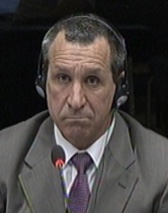
Russian artillery officer Col. Andrei Demurenko went on
television in Sarajevo to denounce the UN report on the explosion
as a falsification. He announced that the probability of hitting
a street less than 30 feet wide from Serb artillery positions one
to two miles away was “one in one million.”
A Canadian specialist with extensive service in Bosnia told
Binder that the fuse of the mortar shell recovered from the
marketplace crater “had not come from a mortar tube at all.”
Two unidentified U.S. administration officials in Sarajevo
explained to Binder that based on the trajectory, the shallowness
of the crater, and the absence of any high-pitched distinct
whistle, the shell was either fired from a very close range or
dropped from a nearby roof into the crowd.
Although Binder is a regular correspondent for the New York
Times, he had to go to The Nation with this story.

The U.S. media’s outrage over the marketplace explosion in
Sarajevo stands in sharp contrast to the great approval for the
U.S. launch of 13 Tomahawk cruise missiles targeting the city of
Banja Luka. Banja Luka is a city behind the Bosnian Serb lines.
It is the second largest city in Bosnia and the city with the
most refugees of all of the former Yugoslavia. In the U.S.-NATO
attack many civilians were killed and one hospital was bombed.
‘END THE ARMS EMBARGO’ MEANS WIDEN THE WAR
The demand to “end the arms embargo” is raised as a simple slogan
of the Bosnian government’s right to defend itself. Like the term
“safe areas” the reality is far different.
“End the arms embargo” means to legitimize tens of thousands of
U.S. troops technically training the Bosnian army in advanced
military equipment, securing airports and roads for landing and
moving heavy equipment. It further involves U.S. surveillance
flights and ground cover in a mountainous region where a
dependent, isolated minority government currently controls small
enclaves. This would greatly expand Pentagon involvement beyond
the CIA training and supply level of today and the NATO air cover
of more than 40,000 sorties in the past three years.
There’s a struggle within the summits of U.S. power between those
who want to rely on U.S./NATO bombing missions to destroy the
Bosnian Serb forces and those who feel the only way to decisively
control and reshape the region is through U.S. ground troops and
an end to the arms embargo. Both sides of the debate seek to
expand and widen the war. Both sides of the debate assert the
right of U.S. finance capital to impose its solution.
WAR IS CALLED PEACE

The newly formed Action Council for Peace in the Balkans best
reflects the cynical double-speak where peace means war. It is
composed of the bipartisan forces of U.S. militarism that are
framing the debate. Members of the Executive Council include
Zbigniew Brzezinski, national security advisor under Carter;
Frank Carlucci, a national security advisor and secretary of
defense under Reagan; Hodding Carter, a state department
spokesperson under Carter; Max Kampelman, who headed Reagan’s
nuclear arms team; and Jeanne Kirkpatrick, Reagan’s United
Nations ambassador.
On July 12, 1995, this Council for Peace in the Balkans issued a
call for “an end to the arms embargo against Bosnia, the
withdrawal of the UN forces from Bosnia and an effective NATO air
campaign.” This “peaceful” group asserts that the “air campaign”
should be “strategic and sustained,” not “pinprick strikes.” The
statement concludes, “A failure to act will be disastrous for the
people of Bosnia, for the U.S., and for our vital interests in
Europe.”
INTER-IMPERIALIST RIVALRY
CIA and Pentagon involvement in the civil war in the Balkans has
positioned the U.S. militarily in a strategic region. At the same
time it has frayed the developing unity among its European
imperialist rivals. These U.S. rivals bear the increasing burden
of hundreds of thousands of destitute refugees, thousands of
ground troops in position and the bitter acrimony of competing
interests.
What appears to be a bureaucratic dispute between NATO and UN
officials is in reality a struggle between the imperialist ruling
class of the U.S. and its European rivals, who fear being drawn
into a protracted war. Each defends its right to carve up this
strategic region in accordance with its own interests. But the
Europeans have troops on the ground. If their forces take
casualties while the U.S. calls the shots, opposition at home
will rise.
There seems to be a great deal of information on close German-
U.S. collaboration at the expense of British and French
interests. But even this may change. The fact that the U.S. arms
and trains the Croatian troops may be a sign that Washington is
asserting itself in Croatia also.
The debate on U.S.-controlled NATO forces helping to evacuate UN
“peacekeepers” reflects an expanding effort to make the U.S. the
only power deciding the fate of the Balkans. Both France’s and
Britain’s determination to be bigger powers in Europe now that
the Cold War is over is reflected in their large commitment of
troops under the UN flag throughout Bosnia.
But the Pentagon has been able to totally frustrate the British
and French troop placements by encouraging the Bosnian
government, which is totally dependent on the U.S., to sabotage
any agreements.
Washington’s November 1994 decision to unilaterally end support
for the UN Security Council arms embargo was the most open
statement to date that it would pursue its own agenda in Bosnia
at the expense of the Europeans. This decision is also at the
expense of the hundreds of thousands of uprooted and displaced
people caught in the crossfire.
SANCTIONS: ECONOMIC DOMINATION OF THE REGION
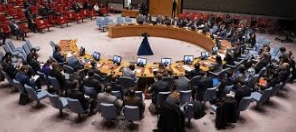
The UN Security Council voted to impose a sanctions blockade on
the remains of the Yugoslav Federation (Serbia and Montenegro) on
May 30, 1992.
The UN Security Council vote was rushed through to pre-empt a UN
report published two days later saying that the Federal Republic
of Yugoslavia was in full compliance with the UN demands that all
Yugoslav Federal Army troops be withdrawn from Bosnia.
These sanctions strangling all economic life were imposed only on
the Serbs, in spite of the fact that the World Court in the Hague
ruled that the Federal Republic of Yugoslavia (Serbia and
Montenegro) was not the aggressor in the conflict in Bosnia.
UN sanctions have not been imposed on Washington’s client states
in the region, the Croatian and Bosnian governments. The UN
Security Council did not even discuss imposing sanctions on the
Croatian government in response to its August 1995 massive attack
on the Krajina section of Croatia and its expulsion or “ethnic
cleansing” of over 200,000 Serbs there.
Although the stated aim of sanctions is to end arms shipments
from Serbia to the Serbs in Bosnia, U.S. and Western powers used
the opportunity of enforcing the sanctions to gain control of all
the roads, waterways and communications in this strategic part of
Europe. All approaches to seaports and airports are sealed off.
The Pentagon now controls all navigation on the mighty Danube
River major thoroughfare of the Balkans and Eastern Europe. All
shipping is restricted. The Danube is more important for Europe
than the Mississippi River is for commerce in the U.S. All
countries of the Danube Basin not only Serbia but Romania,
Bulgaria, Hungary and Slovakia thus effectively come under the
blockade.
The Western capitalist powers are the only ones that stand to
benefit from the resulting economic dislocation in a number of
formerly socialist countries that are now forcibly going through
privatization of their major industries and resources. Entire
industrial complexes, no longer able to be competitive in the
world market or even to receive raw material for production or
ship their goods, can literally be bought for a song by
multinational corporations.
Although medical and humanitarian goods are supposedly exempted,
the sanctions disrupt the entire supply system its markets,
foreign trade, communications and transport. Funds, bank accounts
and credit are frozen. Yugoslavia is a country with limited
resources that is forced to cope with a flood of almost 2 million
refugees displaced from Croatia and Bosnia. More than 40% of the
refugees are under 18 years old. Basic medicines, food, fuel for
cooking, heating and running industries and sanitation are at
crisis levels.
All the imperialist powers, but particularly the U.S., recognize
that Yugoslavia sets precedents for intervention in the former
republics of the Soviet Union. In early December 1994, the summit
of the Organization for Security and Cooperation in Europe met.
Its first military action was to authorize a “peacekeeping
mission” to Nagorno-Karabakh, the enclave disputed by Armenia and
Azerbaijan. The stated purpose of the forces going into Nagorno-
Karabakh is to prevent a Bosnia-like situation. Their track
record is not encouraging.
Ownership and control of the newly privatized industries and
natural resources is at stake. In a war-torn region, all of this
can be bought for a song. Who will control the markets, the rich
resources, the rebuilding and the new investments? Military
control of the situation will be decisive. Diplomacy is only a
cover for the military struggle.
THE PENTAGON PLAN
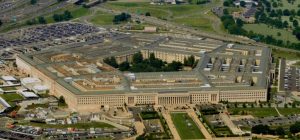
The U.S. is determined to be the dominant power in the Balkans.
This thinking is best reflected in an extraordinary 46-page
Pentagon document excerpted by the New York Times on March 8,
1992. The document, leaked by Pentagon officials, asserts the
need for complete U.S. world domination in both political and
military terms and threatens other countries that even aspire to
a greater role. The public threats seem to be aimed at the
European powers and Japan. Why else would the document be
released with no disavowal by the Pentagon?
This Pentagon policy document states: “Our first objective is to
prevent the re-emergence of a new rival. … First, the U.S. must
show the leadership necessary to establish and protect a new
order that holds the promise of convincing potential competitors
that they need not aspire to a greater role or pursue a more
aggressive posture to protect their legitimate interests.
“We must account sufficiently for the interests of the advanced
industrial nations to discourage them from seeking to overturn
the established political and economic order. Finally, we must
maintain the mechanism for deterring potential competitors from
even aspiring to a larger regional or global role.”
The document goes on to specifically address Europe. “It is of
fundamental importance to preserve NATO as the primary instrument
of Western defense and security…. We must seek to prevent the
emergence of European-only security arrangements which would
undermine NATO.”

No senior U.S. official has ever denounced or renounced this
document. When President George Bush was asked directly about the
document, he said that while he hadn’t read the report, “We are
the leaders and we must continue to lead.”
OPERATION BALKAN STORM

Just how little U.S. involvement has to do with “aiding poor
Bosnia” is best seen in an opinion piece in the Nov. 29, 1992,
New York Times by retired Air Force Chief of Staff Gen. Michael
J. Dugan entitled “Operation Balkan Storm: Here’s a Plan.”
Dugan is best remembered for an unusually candid interview before
the Gulf War where he laid out very precise plans for the
destruction of Iraq. He was relieved of his command for being too
frank in describing the Pentagon’s war plans at a time when the
U.S. was claiming to the UN that it wanted to impose sanctions on
Iraq to pursue a diplomatic solution. However, four months later
the war unfolded almost exactly as Dugan had described.
“A win in the Balkans would establish U.S. leadership in the
post-Cold War world in a way that Operation Desert Storm never
could,” Dugan crowed. He laid out a scenario of coalition
building, if possible, with Britain, France and Italy on an ad-
hoc basis since the UN Security Council is deadlocked on the use
of force by NATO. He described arming the pro-U.S. Bosnian forces
such as those around Izetbegovic and use of “unconventional”
operations in Bosnia to suspend UN humanitarian operations. Then,
he said, massive air power should be used against Serbs in Bosnia
and Serbia. This Air Force general likes to brag about U.S. death
technology. Dugan suggested using aircraft carriers, U.S. F-15s,
F-16s, F-18s and F-111s, Jstars and Tomahawk missiles to destroy
Serbia’s electricity grid, refineries, storage facilities and
communications. “But the U.S. costs in blood and treasure would
be modest compared with that of Bosnian trauma.”
Whether it was the original U.S. legislation of November 1990, or
the recognition of an independent Bosnia under a right-wing U.S.-
backed government rather than the compromise government
acceptable to all sides in March 1992, or the U.S.-brokered
Croatian-Muslim Federation of March 1994 U.S. intervention at
each stage in the growing conflict in the Balkans has fanned the
flames of war.
Whether it is the early 1993 Vance-Owen plan to cantonize Bosnia
into tiny enclaves or the Vance-Stoltenberg Plan of late 1993 for
a three-way partition of Bosnia each proposal is an assertion of
U.S. determination to dominate the region and keep its
imperialist rivals off guard.
Despite the many grim warnings of difficult terrain and low cloud
cover, the Clinton administration has offered to send 25,000
troops as a “peacekeeping” force if a U.S. plan presented in late
August 1995 is imposed on the people of the region. Massive use
of air power began in September 1995. Once committed, more and
more troops will be required in a war that can quickly escalate.
There is a heated debate today in ruling military, corporate and
government circles. But it is not about how to negotiate peace.
It is about how to insure U.S. domination of a strategic region.
THE ONLY SOLUTION U.S. OUT
The analogy to U.S. CIA advisers in Vietnam followed by 25,000
troops to prop up the U.S. puppet Ngo Dinh Diem comes to mind all
too quickly.
The war that is unfolding will not be fought in a Hollywood
fantasy in front of computer screens, as the rank-and-file
soldiers of other U.S. wars know so well. The trauma for millions
of refugees from Southeast Asia continues to this day. It will
cost much more in “blood and treasure” than General Dugan so
callously estimates. A further expose of U.S. war plans and
involvement in the Balkans is desperately needed in order to open
a debate and build a powerful opposition to the latest espisode
in the Pentagon’s plans for world domination.
Concerned people of every political persuasion when confronted
with the gruesome images of the war ask, “Doesn’t the U.S.
government have a responsibility to do something to stop the
bloodshed?” Or the question is posed, “How can the U.S. bring
peace?”
The U.S. economy today is completely dependent on and intertwined
with militarism. U.S. military spending is larger than the
military budgets of all the routher countries of the world
combined. U.S. corporations are totally dependent on the profits
of war and militarism. It literally keeps this system that is
based on profits afloat. More than $250 billion a year is spent
on militarism. This is the only area of the federal budget not
facing drastic cuts.
The implications of greater and greater military involvement are
not discussed with working and poor people here in the U.S. Yet
the decisions will impact on the lives of every one in this
country, in the form of further cutbacks in desperately needed
social services.
All the many nationalities of the former Yugoslavia have shown
from past experience that they are capable of resolving their
differences. They lived together in peace and harmony for 45
years under a socialist federation. Although more than 1 million
people died and millions were uprooted during World War II,
driving out the imperialist invaders became a unifying force that
galvanized all the many divided nationalities.
U.S. involvement in the Balkans is not about helping any of the
people in the region Muslims, Croats, Serbs or Albanians. The
only interest of the Pentagon is in creating weak, dependent
puppet regimes in order to dominate the entire region
economically and politically. Only the giant multinational
corporations will benefit.
The only demand for those genuinely concerned with peace is,
“U.S. out, NATO out.”
The involvement of the Pentagon can only bring wider war, more
death and destruction, shattered lives and hundreds of thousands
of additional refugees.
The same demand needs to be raised by the anti-war movements in
each of the West European countries Germany, France, Britain and
Italy. They and the U.S are imperialist powers, meaning that the
highest profits of the corporations of these capitalist countries
come from their investments and economic control of other less
developed countries.
It is not an easy task to build an anti-war movement. It must
combat all the lies of the corporate media. But it has been done
before. As the war widens and the cutbacks in education,
healthcare and housing continue here in the U.S., this idea will
take root.
The only way to end the Vietnam war was for the U.S. to get out.
The years and years of negotiations were only an excuse to widen
the war, continue the bombing and further the intervention. By
the end of the war, all of South East Asia lay in ruins, the
landscape pockmarked with bomb craters and poisoned with Agent
Orange.
Getting the U.S. and the other imperialists out of the Balkans is
the only way to keep this war from escalating into an even wider
struggle that would engulf the whole region.
————————
ABOUT THE INTERNATIONAL ACTION CENTER
Author Sara Flounders is a coordinator of the International
Action Center. The IAC was formed by anti-war activists who had
rallied hundreds of thousands in the United States to oppose the
U.S./UN war against Iraq. The Center later coordinated an
International War Crimes Tribunal that held hearings in 20
countries and 30 U.S. cities probing the Pentagon s massive
bombardment of that oil-rich country. The U.S./UN sanctions have
contributed to the death of more than half a million children in
Iraq and have been a focus of continuing work by the IAC.
Initiated by former U.S. Attorney General Ramsey Clark, the IAC
has also been vital to building opposition to the 35-year U.S.
blockade of Cuba and organizing shipments of medical aid to the
socialist island. International Action Center
39 West 14th St., Suite 206, New York, NY 10011
_________________________